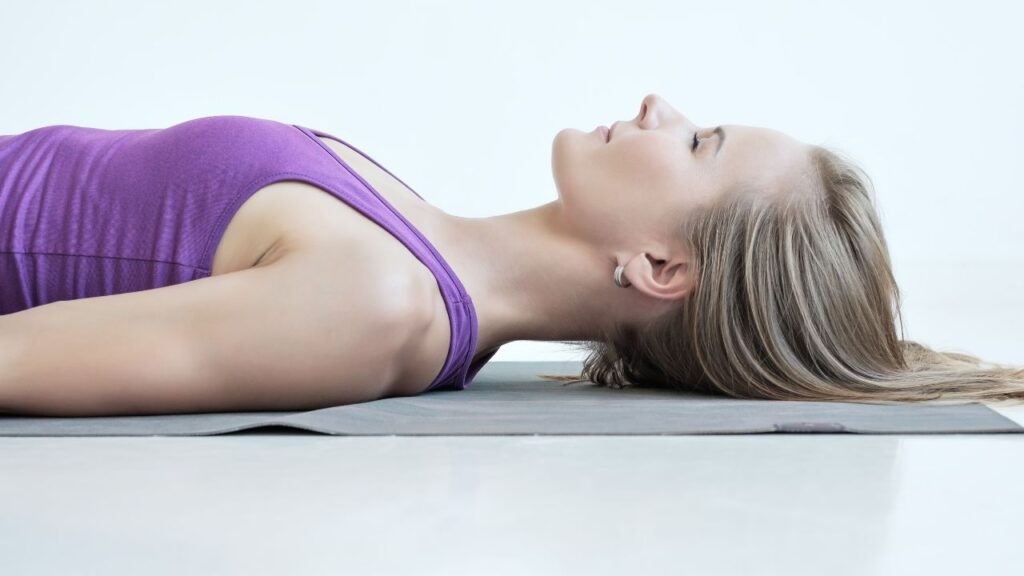We feel like relaxing on a mat, blanket or even in bed. But do you know there’s a style of yoga that leaves us relaxed while you are still awake? Yoga Nidra for sleep is a kind of meditation technique that gives us deep relaxation and leaves us energized and refreshed. A person attends a state of peacefulness as he undergoes complete meditation. Read also: Which Is Better For Weight Loss: Cardio or Weights.
Let us know what is Yoga Nidra
Yoga Nidra Is a form of guided meditation also known as “yogic sleep” or “effortless relaxation”. It needs to be practised under the guidance of a teacher. It lasts for about 45 minutes. In practising, a person learns the difference between the state of wakefulness and sleep. It balances its sleep and becomes quiet, unconscious. The mind remains conscious and persons fall into a state of sleep remaining aware.
When a person rests he starts to experience the deeper features of yogic teachings that we previously didn’t even consider. After the practice of yoga Nidra, a person feels heeled, restored and awakened to the deepest. Read also: Calories Burned For Walking A Mile And Its Benefits For Weight Loss
How to do Yoga Nidra
- For practising yoga Nidra finds a recording of someone reading aloud Yoga instructions. A good recording will be a soft, soothing feel while being clear.
- Prepare blankets, a soft mat or another comfortable surface to sit or lie on. To practise a successful Yoga Nidra its very important to be comfortable.
- Prepare any comforts such as incense, a candle, or a miser. Do not use any strong perfumes or artificial fragrances while practising yoga. Scents are important for encouraging emotional reactions.
- Wear loose clothing to be comfortable and breathe easily. Any specific clothes are not needed, but loose and comfortable clothes only.
- Warm up with sun salutations or Surya Namaskar. A few rounds of it can be effective for preparing your muscles and mind to practise yoga. If it’s not relaxing then practise yoga asanas.
- Make the room as quiet as possible to concentrate fully. It must be silent. If it’s not possible try keeping the room quietly.
- For practising lie down on a mat with keeping your back flat, arms stretched out by the sides. Extend your body how much you can, flattening your body out.
- Close your eyes and relax your eyelids. Shut your eyes.
- Take a couple of deep breaths, emphasizing exhalation. Breathe through your nose and fill the air in your lungs, exhale through your mouth. Make a count of 10.
- When recording instructs you, rotate and visualize the said body part. Focus only on the body parts and don’t allow your mind to distract you.
- Repeat again and visualize body parts. We should feel completely relaxed by assuming that all tension is gone.
- Prepare to return to ordinary conscience. Gently move your fingers for a few moments by taking a deeper breath and then open your eyes. Expect to come out of yogic sleep naturally, whether you return after 15 minutes or a whole hour.
- Return to sitting position. Do not get up, simply Crisscross or if you are more advanced try sitting in the lotus position.
- If you have more time practise some asanas. This helps the body to become fully awake and completely out of yogic sleep.
Benefits of Yoga Nidra
- It greatly helps to improve thought patterns and reduces stress. The practice creates physical and mental activities that allow the brain to release emotional tension and slow down the nervous system which makes muscles relax.
- Yoga Nidra helps to enhance cognitive performance and memory by creating space in the brain. Those who practise Yoga Nidra on regular basis can destress themselves.
- It helps to improve self-esteem and confidence on regular basis. An essential step in guided meditation includes setting intentions for the person.
- Better sleep and improved physical health can be obtained as sleep quality is quite improved.
- While practising Yoga Nidra our mind will be quiet and enters a state of the sleep-like state. This way person realises how thoughts affect the mind and how you can let them go.
- It greatly helps in diminishing the symptoms of anxiety and depression as mental calmness is achieved. A person attends a deep physical and emotional relaxation.
- Yoga Nidra also helps to treat chronic pain and post-traumatic stress disorder. A person attends a deep relaxation state which leaves them well rested. The body can also help to recover, rest and restore. Read also: 31 Proven Ways To Lose Weight Without Exercise
Why Yoga Nidra is good for sleep

Yoga Nidra is beneficial as it helps to activate the relaxation response and improves the functioning of the nervous system along with the endocrine system. It greatly helps the cells to repair, and regenerate which helps to decrease anxiety and improves a person’s mood.
Remember that yoga Nidra is not a sleep substitute. Many people say that it’s practised for 45 minutes but feel like sleeping for 3 hours or so. A person wakes up deeply refreshed after practising yoga Nidra.
Difference between Meditation and Yoga Nidra
In short, the answer is no. Its because meditation is very difficult to define as it can be practised in many different ways. Yoga Nidra is much more than meditation. Meditation is most experienced in the waking state where the Beta and Alpha waves are there in the Brain. In Yoga, the Nidra person experiences deeper layers in form of sleep but in a conscious state.
Meditation is practised in a seated position while yoga Nidra is practised in a lying down position. Mediation is self-guided with more silence and less direction. On other hand, Yoga Nidra is entirely guided which helps if you are unfamiliar with what to do. It keeps a person free from anxieties, busy minds and thoughts. Read also: Am I bloated or fat find it here Scientifically
How to get ready for yoga Nidra
- In order to get ready, the stomach has to be light before the practice. It’s not recommended to practise yoga asanas after a full meal.
- Space should be comfortable and clutter-free in order to relax.
- Some people after practising yoga Nidra feel cold, it’s better to keep a blanket ready for your hand.
Yoga Nidra is to make a person feel relaxed with awareness, remain effortless and consciously relax the mind. It’s more like an effortless way to end the yoga practice. It’s a super nap that leaves a person refreshed and relaxed in its own way.
Initial relaxation
Intention
Body rotation
Breathe and energy awareness
Sense perception
Visualization
Sankalp
Externalization
A person obtains many advantages such as there is relief from muscular pain. Emotional and mental tension can be greatly reduced. Stress and anxiety can be greatly reduced as min is completely relaxed after practising yoga Nidra. It helps to treat insomnia and physiological distress and disorders. Mind attends training as memory power is enhanced and learning capacity is increased in a person
Yoga Nidra can be practised when any person is convenient according to the timings. It’s the most accessible yoga practise that anyone can opt for. In order to obtain maximum benefits, one has to practise it regularly. If not try practising 3 to 4 times a week.
With too much practice of Yoga Nidra, one can experience poor sleep instead of obtaining better sleep. The low immune system along with general health problems are even seen in excess practice. When a person practises yoga Nidra the brain remains in an active state as waves are released.
Yoga Nidra is good for depression as mild to moderate symptoms of it can be greatly cured with it. However, those who have severe anxiety issues and depression symptoms cannot overcome more by practising yoga Nidra.







